In October, 1971, Avengers #95 brought us what might be the most unusual installment yet in the ongoing epic of the Kree-Skrull War. From one perspective, concerned primarily with the progress of the war and the Avengers’ role in it, it could quite reasonably be deemed the least consequential chapter in the entire saga. From a different point of view, however — namely, that of the Inhumans — it might be the most significant of all.
That’s because Roy Thomas and Neal Adams took advantage of the opportunity Avengers offered not only to wrap up the story they’d begun telling in their most recent previous collaboration — the “Inhumans” strip in Amazing Adventures — but also to deepen the Inhumans’ mythos; especially that part of it wrapped up in the personal histories of the two royal brothers, Black Bolt and Maximus, whose animus had been the driver of most of the narratives Marvel Comics had produced concerning that hidden race ever since Stan Lee and Jack Kirby introduced them back in 1965.
It’s just too bad that they didn’t tell their successors on Amazing Adventures, Gerry Conway and Mike Sekowsky, so that the latter hadn’t presented their own, somewhat contradictory continuation of that same narrative, in what would turn out to be the final two installments of the Inhumans’ own series… but we’ll get to that later in the post. First up, however, is Avengers #95’s “Something Inhuman This Way Comes..!” — a story whose title follows the precedent (set by Thomas in previous installments of this saga) of alluding to a title of a well-known work of non-comics science fiction. In this case, it’s a double allusion, as the primary reference is to Ray Bradbury’s Something Wicked This Way Comes (which, when you get right down to it, is a dark fantasy novel and not SF at all, notwithstanding Bradbury’s being best known as a writer in the latter genre… but I digress) — whose title itself comes from a line in Shakespeare’s Macbeth (also not SF… but you already knew that).
Artist John Buscema had illustrated one chapter to Neal Adams’ two in the previous issue of Avengers, but despite Buscema pencilling issue #95’s cover (a fact I’m pretty sure eluded my fourteen-year-old self in 1971, due to the impression of visual continuity lent by Tom Palmer’s distinctive inking on both the cover and the interior art), it’s all Adams inside this time. Interestingly, the story doesn’t pick up immediately where #94 left off, with the Inhuman Triton climbing out of a manhole on the grounds of Avengers Mansion, but rather jumps back one hour, to the moment of his arrival on the New York waterfront. This allows our storytellers to fill us in on how the aquatic Inhuman got into the sewer system in the first place; happily, it also allows Adams (with scripter and co-plotter Thomas’ cooperation, obviously) to give us one of his by-now-trademark “maximum panels/minimum words” pages:
With the following page, we’re back to where the last chapter ended, as Triton surfaces right in the middle of a pitched battle between the Avengers and a cadre of armored S.H.I.E.L.D. agents called the Mandroids…
Meanwhile, the “misguided but influential patriot” mentioned in the last panel above — H. Warren Craddock, the head of the recently-formed Alien Activities Commission (aka the guy who’s been making the Avengers’ lives hell since issue #92) — is monitoring the proceedings via three screens that give him individual Mandroid-eye-views, while S.H.I.E.L.D. Director Nick Fury looks on unenthusiastically from yet another screen. Then, suddenly, there’s a problem:
Yeah, nice work, Shellhead. But you couldn’t have whipped out those power-pods before making us suffer through the debacle of your transistor-powered roller skates at the end of the last issue?
Along with a succinct explanation of just who and what these “Inhuman” folks are, Thomas and Adams have just given us a tidy summary of their storyline from Amazing Adventures #5 through #8 — and though it leaves out a lot, obviously, it nevertheless provides the uninitiated reader all the information needed to follow the story from here. Not bad at all for four panels.
Despite Iron Man’s spluttering indignation, the Vision has a point. As dire as the Inhumans’ predicament is, is it really so urgent as to justify the Avengers’ setting aside this whole Kree-Skrull War business to deal with it right now? Interestingly, the Vision buries the lede (perhaps understandably, from his point of view), via his all-too-brief mention of the Super-Skrull’s attempted obliteration of the Great Refuge, Attilan, in Avengers #94. That little fact would, if given more time and consideration, clarify for the Avengers that the situation with the Inhumans represents just one more front in the interstellar war they’re already dealing with — it’s all one “case”, in other words. But, no, we don’t go there.
And so, via the time-honored super-team tradition of dividing into groups, the immediate conundrum is solved. Unfortunately, what the Avengers don’t know is that S.H.I.E.L.D. has a back-up system for the Mandroids, allowing the armored suits to be operated by remote control from a helicopter hovering nearby…
Some time has obviously passed since the last time Thomas and Adams chronicled the doings of the Inhumans; at the conclusion of Amazing Adventures #8’s “An Hour for Thunder”, Black Bolt’s costume was in the possession of the authorities, and he was still suffering from amnesia. Somehow, he’s managed to retrieve his power-modulating duds since then; and as we’ll see a couple of pages from now, he’s recovered his memories as well. Otherwise, however, the status quo doesn’t seem to have changed much from where Thomas and Adams left things; from all appearances, Black Bolt’s family have yet to reunite with him, and the Inhuman monarch and his young friend Joey are still out on their own on the streets.
There’s some risk-taking going on with the layout at the bottom of page 11, as the reader is asked to take the counter-intuitive step of reading the captions from right to left. I think the overall effect is worth a moment or two of confusion, but I can see how others might disagree.
From here, we move into a three-page flashback sequence which is both the narrative centerpiece of the issue and its aesthetic high point, at least as far as your humble blogger is concerned. (That’s in spite of Thomas’ rather odd reference to Superman’s Kryptonian dad in the first panel — read “Le-Roj” backwards — which I can only surmise was inspired by the garb Adams designed for the young Black Bolt, which bears some superficial resemblance to the outfit Jor-El was usually depicted as wearing in the Silver and Bronze Ages.)
These three pages fulfill an important function in the present Kree-Skrull War storyline by establishing a direct connection between the alien Kree and Maximus the Mad — the villain of most Inhumans stories to date, including the one that Thomas and Adams had been chronicling recently in Amazing Adventures. But it also significantly expands upon the Inhuman royal family’s backstory in a way that ultimately enriches the greater Marvel Universe. Stan Lee and Jack Kirby had given us glimpses of the early days of Black Bolt and his kindred, including Maximus, in the Inhumans backup feature that ran in Thor in 1967-68. But those stories had never given any inkling of the revelations offered here by Thomas and Adams — of how Black Bolt’s own actions many years past had inadvertently led not only to Maximus’ insanity, but to the deaths of both their parents. This is a frankly brilliant continuity implant which, while fitting in perfectly well with the history readers already know, adds an element of tragedy that wasn’t there before — one that will (or should) inform virtually every future story to be told concerning these characters. The icing on the cake is the almost monochromatic coloring, probably by Tom Palmer, which washes the entire memory sequence in varied shades of blue for an indelible effect.
So, thanks to the Vision feeling guilty about having hogged the most powerful Avengers for his own mission, the second unit of heroes ends up… rejoining the first, without having taken a single step towards achieving its own objective. Frankly, it’s hard to see there having been any good narrative reason for splitting the team up in the first place, beyond the minor character beat for Vizh. Maybe Adams and Thomas just wanted to give the Mandroids a bit more on-panel time…
After being deposited by Mjolmir’s enchantment directly in front of the dome-shaped barrier enclosing the entire Great Refuge, the three Avengers apply their collective might to attempt to break through — only to find it impervious to all three of their power sets…
Let’s pause here a moment to note that the top of page 19, as shown above, gives us the first non-flashback appearance by either a Kree or a Skrull we’ve had this entire issue.
Oh, so Black Bolt knows where and how to find his cousins once he gets back to San Francisco? That’s… unexpected. And what will Black Bolt do about little Joey, whom it’s been established is an orphan, and who was previously living under the dubious guardianship of his now-late lowlife uncle Roscoe? Joey’s already made it clear that he’s come to view BB as a father figure, and the Inhuman king’s own feelings for the boy have been made evident in his bringing him along on this intercontinental jaunt in the first place.
I wish I could tell you that Black Bolt and Medusa adopt Joey as their own son and take him to live with them in the Great Refuge, where he’ll henceforth provide a human perspective on the Inhumans’ adventures… but I’m afraid I can’t. As best as I’ve been able to determine from my research, we never see Joey again after Avengers #95. I guess we’ll just have to hope that Black Bolt and his family at least turned the poor kid over to Social Services before taking off again for their home in the Himalayas…
The stage is now set for the final act in the epic drama of the Kree-Skrull War. With next month’s penultimate chapter, the action will finally move completely off Earth for the very first time in this seminal superhero space opera — about time, wouldn’t you say? We’ll see you here in November for Avengers #96.
 And now for those two Amazing Adventures issues that wrapped up the Inhumans’ own series — sort of — completely independently of what was going down at the same time in Avengers.
And now for those two Amazing Adventures issues that wrapped up the Inhumans’ own series — sort of — completely independently of what was going down at the same time in Avengers.
We’ll begin with Amazing Adventures #9 (Nov., 1971), which went on sale in August. (Incidentally, and as we’ve mentioned in previous posts, this was one of the very few comics Marvel published during their “Giant-Size Marvel Month” that wasn’t giant-sized.) It’s unlikely that anyone would have been looking for connections between this issue and the concurrently published issue of Avengers (your humble blogger certainly wasn’t, at any rate), because the Inhumans had yet to be so much as mentioned in any of Roy Thomas’ “Kree-Skrull War” scripts for that series — and regardless of the Kree’s role in the Inhumans’ origins, there wasn’t any real reason to assume that they would be in the future. After all, they hadn’t played a role in any of the Kree-centric storylines that had dominated the 1968-1970 run of Marvel’s Captain Marvel title.
As Gerry Conway and Mike Sekowsky’s story opens, it seems pretty clear that we’re picking up in the aftermath of AA #8, with Medusa, Gorgon, and Karnak still searching for the lost, amnesiac Black Bolt on the streets of San Francisco. (Triton’s absence is accounted for by his having become separated from the group back in issue #7.*)
The Trikon! From this set-up you might expect this mysterious trio of twinkly lights to play a major role in the story that follows — but if you did, you’d be wrong. In introducing the Trikon this early on, our storytellers were simply playing a long game — unadvisedly, as things turned out. No, the main threat in this issue’s episode is, rather, that mutant master of magnetism, Magneto — who’s somehow gotten the erroneous idea into his head that Black Bolt and his kin are mutants, and is determined to make allies/slaves of them, by any means necessary. (In Maggy’s defense, that idea seemed to be going around at the time — witness the Super-Skrull’s reliance on the similarity of “brain-waves” between those of the mutants Quicksilver and the Scarlet Witch to those of the Inhumans to locate the Great Refuge in Avengers #94.)
To this end, he sends one group of mutant minions to capture the trio of Medusa, Gorgon, and Karnak — an attempt which is less than successful — and another to waylay Black Bolt (still without his costume, as well as his memory) — which goes rather better:
Leaving an unconscious Joey behind, the minions carry BB off to their master’s lair, where the Inhumans’ sovereign eventually awakes to find himself a helpless prisoner — though at least he’s back in his costume, so there’s that:
But Black Bolt’s fam, utilizing information provided by one of their own would-be captors, manages to locate Magnetos hideout. They break in to rescue him — and it’s in this moment, when he lays eyes on his long-lost beloved, that his memory at last returns:
But as things turn out, this is all part of Magneto’s plan to get all of the Inhuman royal family together and capture them, which he does. This issue ends with a tease that the captives’ only hope may be the boy Joey…
…though, in the end, it’s only a tease — as we’re about to see.
 For Conway and Sekowsky’s follow-up in the next issue, Bill Everett was replaced on inks by Frank Giacoia (not an improvement, I’m afraid). As Amazing Adventures was a bi-monthly, issue #10 was published in October; going by the approximate release dates given at Mike’s Amazing World of Comics, it would have arrived on stands about a week after Avengers #95. That made it likely that many, if not most, avid Marvel readers would already have perused the latter comic before digging into this one — which, in turn, would make it likely that, like my fourteen-year-old self, they would finish the issue feeling somewhat dismayed and confused.
For Conway and Sekowsky’s follow-up in the next issue, Bill Everett was replaced on inks by Frank Giacoia (not an improvement, I’m afraid). As Amazing Adventures was a bi-monthly, issue #10 was published in October; going by the approximate release dates given at Mike’s Amazing World of Comics, it would have arrived on stands about a week after Avengers #95. That made it likely that many, if not most, avid Marvel readers would already have perused the latter comic before digging into this one — which, in turn, would make it likely that, like my fourteen-year-old self, they would finish the issue feeling somewhat dismayed and confused.
Despite that last-panel tease in issue #9, we see our pal Joey all too briefly in #10’s “– In His Hand… the World!” On page 6, the boy regains consciousness on the San Francisco wharf where Black Bolt’s abductors had left him:
…but sometimes, like the song says, tomorrow never comes. The Inhumans ultimately free themselves from Magneto and his crew without help from poor Joey (I’ll spare you the details); the climax of the story comes with an explosion in which the evil mutant leader seemingly dies — though Conway’s narrative captions on the story’s final page make it pretty clear that Marvel knows as well as its readers do that there’s absolutely no way a major villain like that is gone for good:
And that’s that for this story, as well as for the Inhumans’ run in Amazing Adventures. As this installment only ran 16 pages (a reprint of one of those aforementioned Inhumans backups from Thor rounded out AA #10’s page count), it seems probable that at some point the contents of both #9 and #10 were intended to run as a single extra-length story in a 25-cent issue. But then Marvel publisher Martin Goodman pulled the plug on the “giant-size” experiment, one story became two… and, ultimately, the Inhumans lost their series, period, as they yielded their AA slot to a new X-Men spinoff, featuring the Beast. (And yes, if you’re wondering, we will indeed be covering Hank McCoy’s first solo outing come December.)
Still, at the time Conway wrote his script(s), it’s clear that he expected to be settling in for a run of at least several issues. The next installment would probably have segued into the Trikon storyline, which I’m guessing would either have been concluded before Black Bolt and company headed back to the Great Refuge to oust Maximus, or would have somehow incorporated the latter event. Instead, however, we got this story’s final caption, referring us to Avengers #95 (“now on sale“) for the wrap-up of the Maximus plotline… and promising to “fill in the rough gaps between those two sagas at some near future date!”
You’ve probably already guessed this, but that “near future date” has yet to arrive. But hey, what’s half a century between friends?

Panel from Inhumans Special #1 (Apr., 1990). Text by Lou Mougin, art by Richard Howell and Vince Colletta.
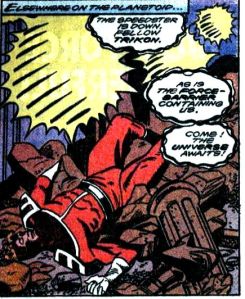
Panel from Quasar #15 (Oct., 1990), showing the Trikon gloating over the unconscious form of the Eternal Makkari (long story). Text by Mark Gruenwald, art by Mike Manley and Dan Panosian.
About as close as Marvel ever got to filling in those “rough gaps” came in a couple of stories published in 1990. First, in Inhumans Special #1, the origin of the Trikon was revealed. (Put succinctly as possible, they were three members of the Inhumans’ genetically-engineered slave race, the Alpha Primitives, who, some years back, had been transformed into entities of pure mental energy by concentrated exposure to the Terrigen Mists; their attempted rebellion was quickly put down, however, and they were banished to the Negative Zone by Black Bolt.) Then, in Quasar #14 and #15, the Trikon were shown to be current “research subjects” of the cosmically-powerful entity the Stranger, interred on his Labworld; they may have escaped when the Stranger’s enemy, the Overmind, freed all of the Stranger’s prisoners as part of that storyline… or not.
But what happened to the Trikon between Amazing Adventures #10 and Quasar #14? How did the Inhumans defeat them the second time, and rescue Joey in the process? And how (and why), after all that, did Black Bolt and Joey end up separated from the other Inhumans, so that they were in a position to be menaced by those gun-wielding crooks on pages 9 and 10 of Avengers #95?
Your guess is as good as mine, true believer. For that matter, it’s probably as good as those of Roy Thomas and Neal Adams, who may not have even heard of this “Trikon” business when it came time for them to produce “Something Inhuman This Way Comes!” Or, if they had, didn’t care all that much about it.
Not that I blame them all that much, I suppose. After all, they still had a Kree-Skrull War to win…

 *Wondering about the absence of those two other prominent members of the Inhumans’ royal family, Crystal and Lockjaw? We touched on this briefly in an earlier post, but here’s a more detailed account: Crystal had left the Fantastic Four back in issue #105 of their title after Reed Richards discovered that her health was suffering due to the pollution prevalent outside the Great Refuge. In FF #117 (Dec., 1971), readers learned that Crystal’s attempt to teleport back home with Lockjaw had somehow gone awry, and they’d ended up in the far future, where they were taken captive and brought under the influence of Diablo. They all then returned to the present day, ending up in the Central American nation of Terra Verde, which Diablo began attempting to overthrow by making Crystal pose as a Mayan goddess named Ixchel.
*Wondering about the absence of those two other prominent members of the Inhumans’ royal family, Crystal and Lockjaw? We touched on this briefly in an earlier post, but here’s a more detailed account: Crystal had left the Fantastic Four back in issue #105 of their title after Reed Richards discovered that her health was suffering due to the pollution prevalent outside the Great Refuge. In FF #117 (Dec., 1971), readers learned that Crystal’s attempt to teleport back home with Lockjaw had somehow gone awry, and they’d ended up in the far future, where they were taken captive and brought under the influence of Diablo. They all then returned to the present day, ending up in the Central American nation of Terra Verde, which Diablo began attempting to overthrow by making Crystal pose as a Mayan goddess named Ixchel.
This all comes to light when Crystal’s boyfriend Johnny Storm, the Human Torch, flies to the Great Refuge to see her and discovers that not only is she not there, but the whole place has been taken over by Maximus. Soon afterwards, in issue #118 (Jan., 1972), the whole Fantastic Four heads to Terra Verde, where they ultimately set everything to rights, defeating Diablo and freeing Crystal from the villain’s mind control. At the story’s end, Crystal tells Johnny that she wants to remain with him, but she can’t:
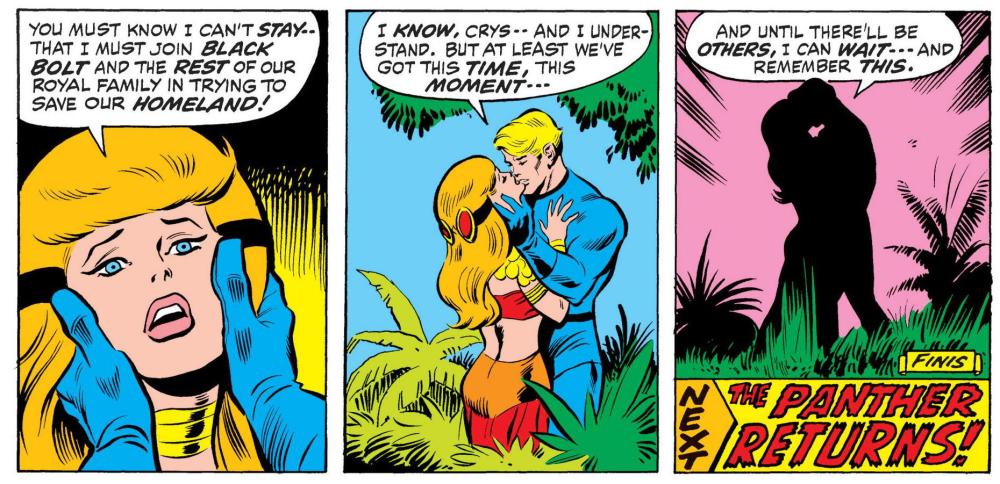
Closing panels from “Thunder in the Ruins!”, Fantastic Four #118 (Jan., 1972). Text by Archie Goodwin; art by John Buscema and Jim Mooney.
It’s interesting to note that while Johnny is understanding of her decision, it apparently never crosses his mind to go with her to, y’know, help. Nor does it seem to occur to the rest of the FF. We can say it’s a moot point, as by the time Crystal does reunite with her family, she’ll probably discover that the crisis has been resolved in the interim. (FF #118 was published in October, same as Amazing Adventures #10 and Avengers #95.) Still, there’s no way the FF could know that at the time Crystal makes her decision. Instead, they basically bail on their former teammate (and in the Torch’s case, his beloved): “Good luck saving your homeland from Maximus, Crys! See ya when we see ya.”
I dunno, folks. I’m starting to get the idea that Triton should count himself fortunate that the FF were out of town when he arrived in New York, and that he ended up with the Avengers, instead. At least Earth’s Mightiest Heroes gave a damn, you know?
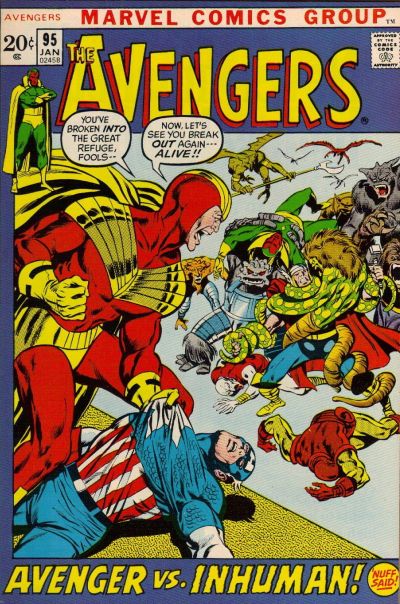



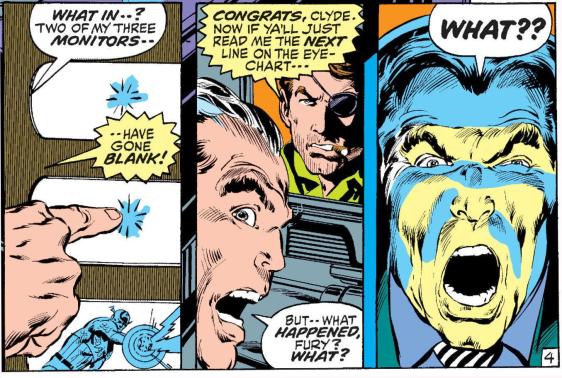







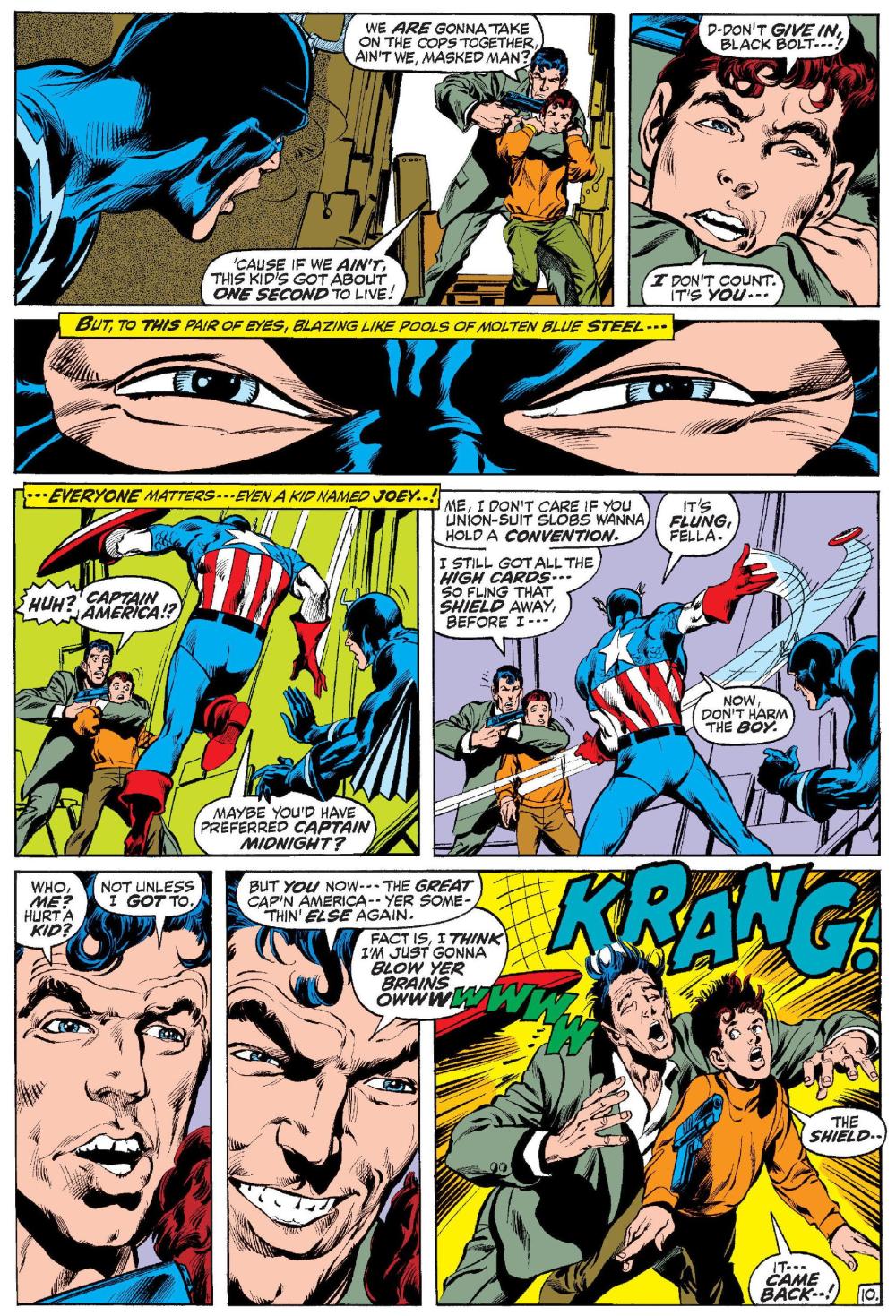




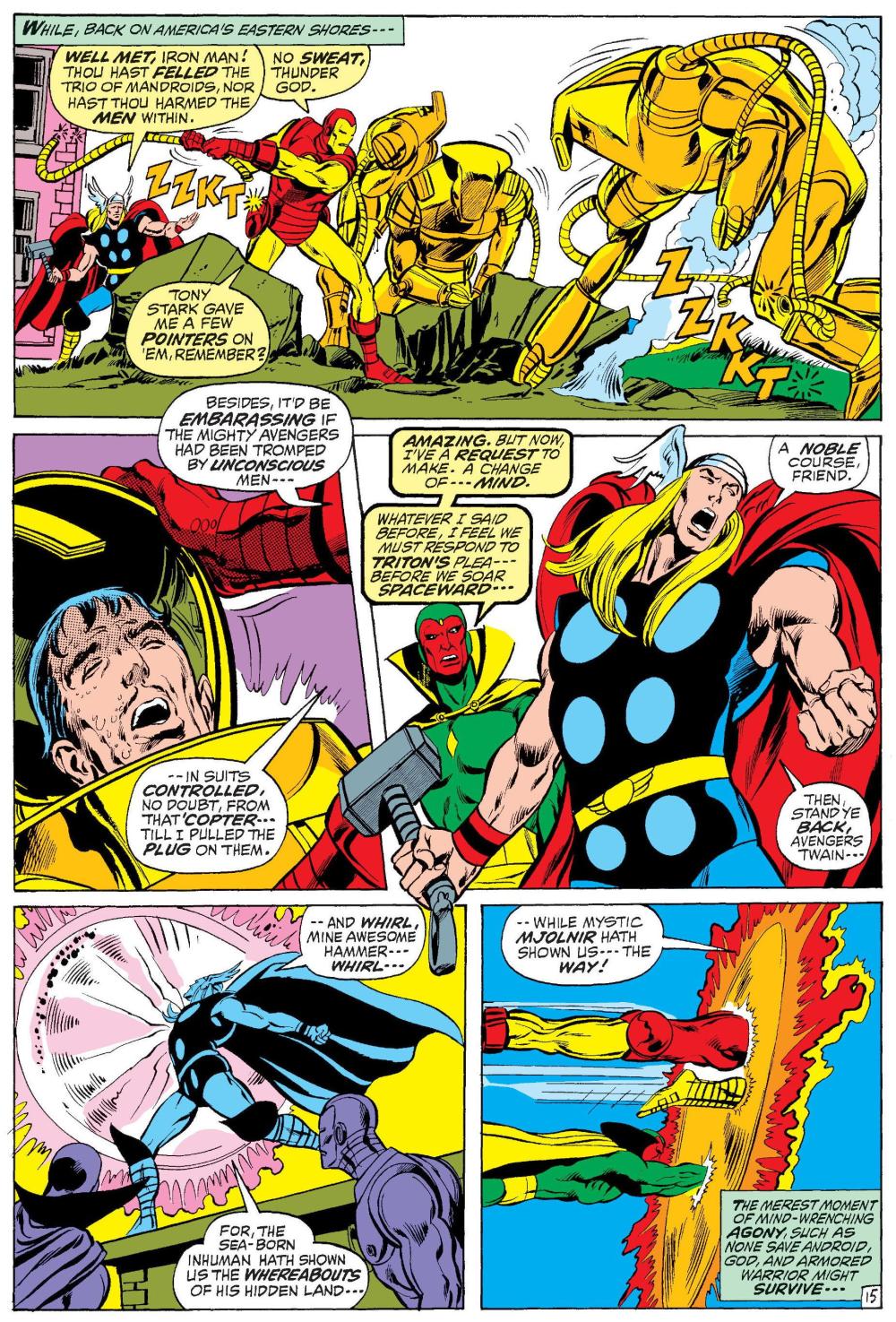

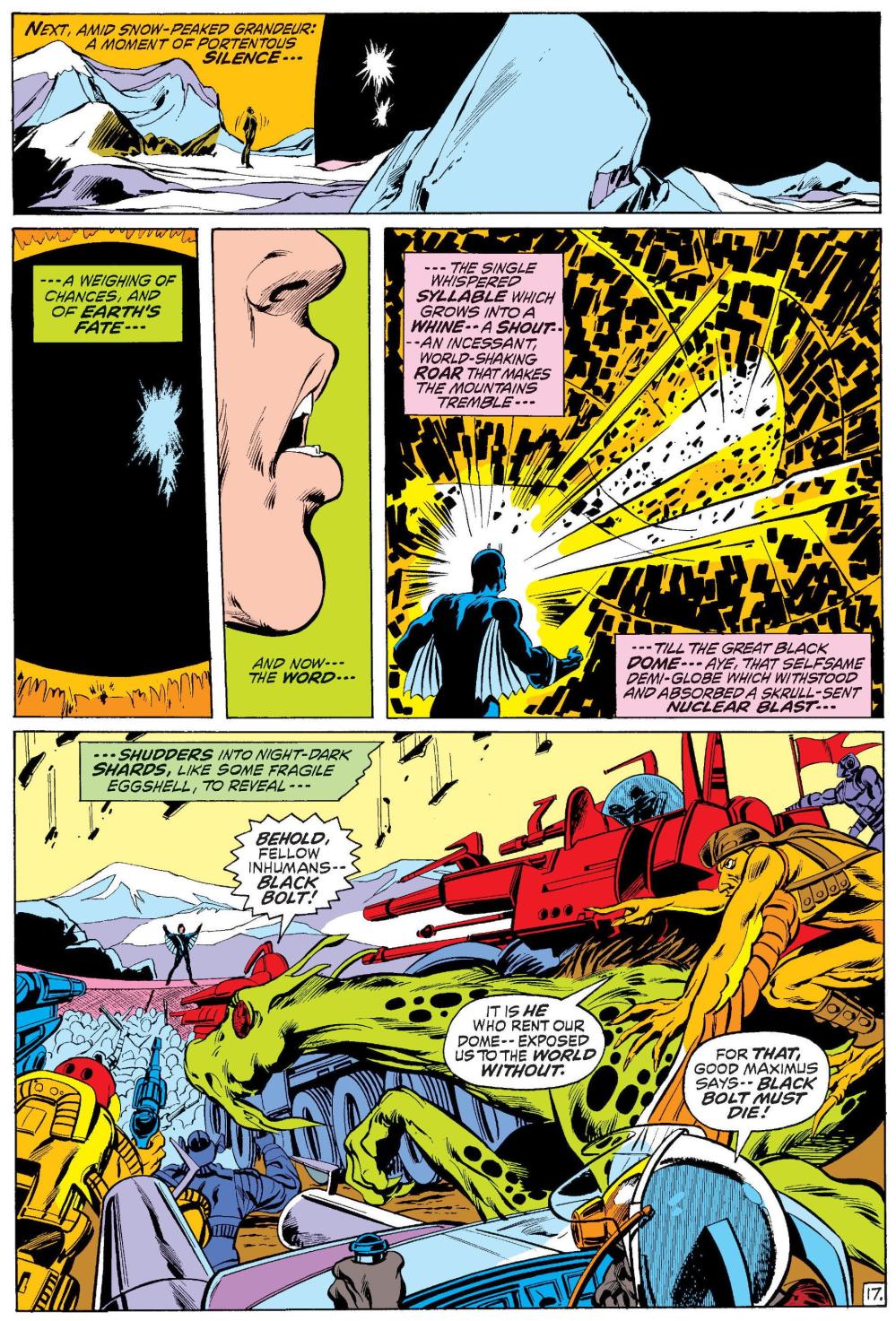

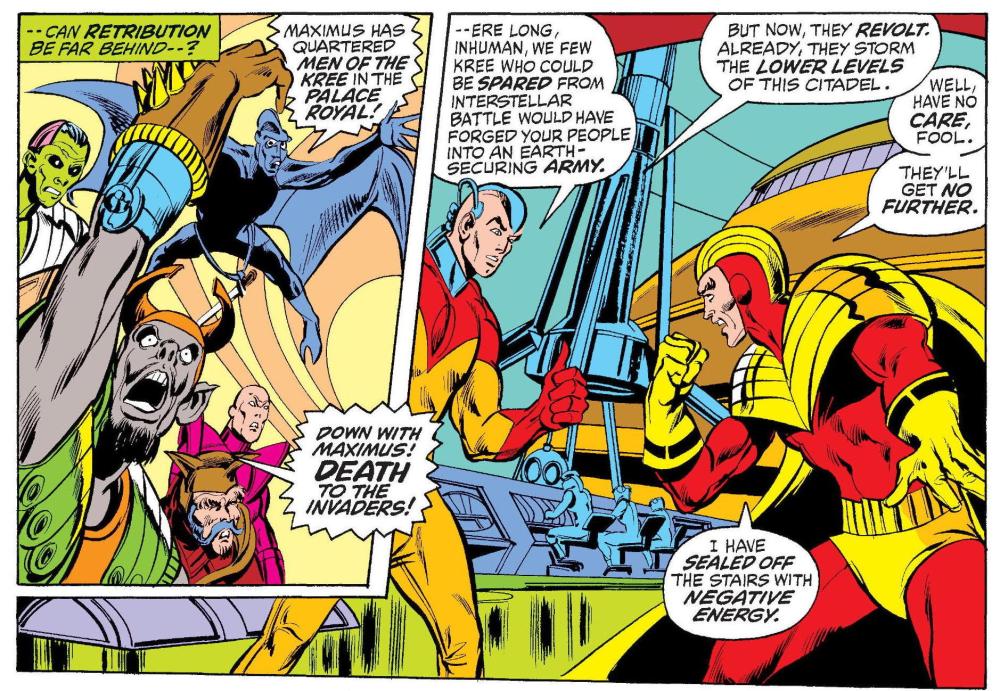
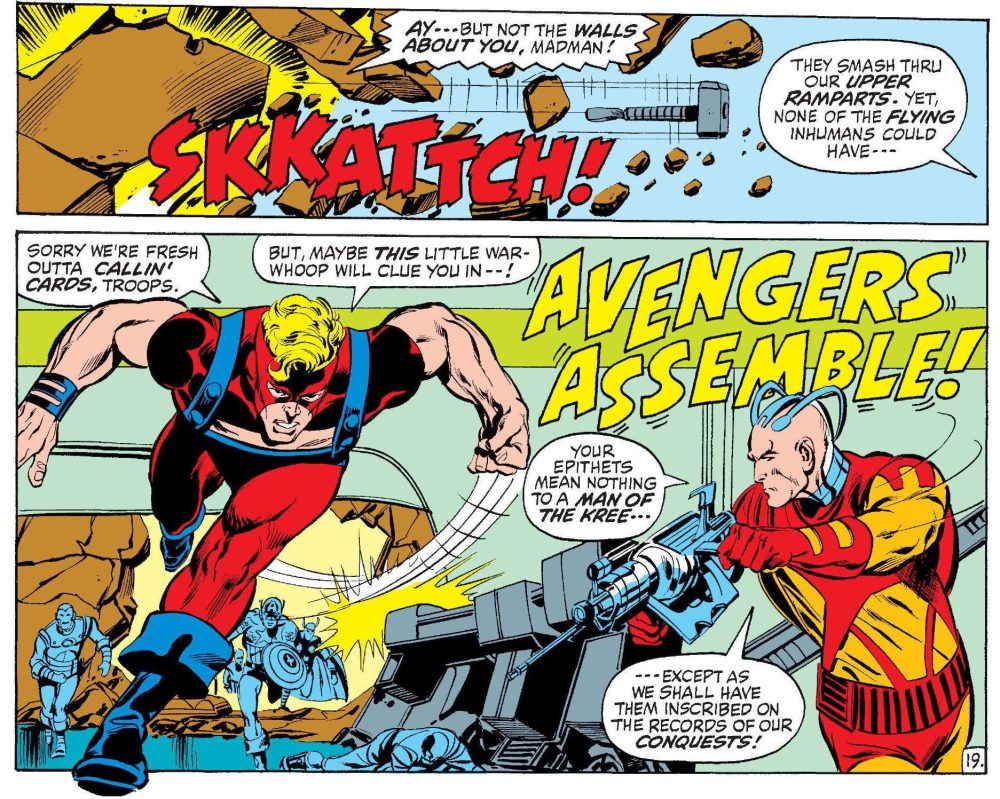











It’s always been a bit of a head-scratch for me that all the aquatic heroes weigh themselves down with boots and gloves and other acoutrement and equipment that only serves to make it even more difficult for them to cleave through the water and get where they need to be. Namor’s costume may seem silly (and brief), being nothing more than a scaled speedo, but at least it’s logical for the character and the world he lives in. For some reason, the image of Triton crawling out of the Atlantic (or the Hudson River, or whatever) in bright red boots and gloves seems particularly ludicrous to me, especially given Triton’s otherwise inhuman appearance, but hey, that’s super-heroes and comic books for you, so what can you do? It does nothing to drive the story or take away from it, so why worry about it? Thomas and Adams certainly aren’t.
Adams artwork on this issue is particularly good, but while I wasn’t thrown off by the reverse caption boxes on pg 11, I did get a little lost on that three page flashback. Not egregiously so, but still. All in all, this issue is a great example of the breadth of Adams’ talent and his impact on the artform. It’s amazing to me that while Kirby goes one way with his overly-exaggerated characters and dynamically cartoony style, Adams can be equally effective and influential by going in the exact opposite direction, keeping things as realistic as possible. I guess comics really does contain multitudes.
Since I didn’t read this story fifty years ago, I don’t have any particular insights into it except to point out the clumsiness of some of Thomas’ plot points. As you pointed out, Alan, Vision’s change of heart in accompanying Triton to Attlan was a needless attempt to split up the team and remind the reader that Vision had the hots for Wanda and made no sense in the context of what was going on. And on page six in relating to the Avengers the circumstances that led him to them in the first place, Triton refers to Maximus as Black Bolt’s cousin, when we all know that they’re brothers. I’m thinking Thomas originally intended for Triton to refer to Max as HIS cousin and the sentence got twisted halfway through (I’ve had that happen more than once), but it’s weird that no one caught it in editorial.
Finally, in comparing this tale to the Inhumans yarn concocted by Gerry Conway, with seemingly little to no discussion with Thomas at all as to the storyline, is it just me or does Sekowsky add almost ten years to young Joey’s age? Adams’ version of Joey looks to be around ten. Sekowsky’s Joey looks to be anywhere from 13-16 and I found that difference rather jarring. Take a look at that picture of Joey lying on the ground on pg 20 of AA #8. If you’d asked me who that was in the context of the story, I’d have guessed Rick Jones rather than Joey. That kid on page 20 looks at least 18 years old! Has no one really ever gone back to tell us what happened to the poor kid? Seems like there’s at least one story to be told here and I know I’d be interested in seeing someone tell it.
It’s interesting to be able to go back and look at these books now, fifty years later. I really wasn’t an Avengers or Inhumans fan back in the day and it’s obvious I missed a few things. Thanks for catching me up.
LikeLiked by 2 people
Walp, I can hardly fault Marvel editorial for not catching that “cousin” gaffe, as I’ve never noticed it myself in all these years. 🙂 Also, as fred suggests, “editorial” was probably 95% Thomas at this point.
LikeLiked by 1 person
I can understand Don’s feeling that Triton looked ludicrous coming onto the pier out of the water with his boots & gloves, IMO that was a magnificent splash page. By comparison, while Sekowsky’s is certainly adequate, it can’t help but look like dreck compared to Adams’ art. Story wise, a lot of high drama in Avengers #95 and significant revelations on Black Bolt & Maximus (surprised Thomas didn’t ever try to work out a story in which Mad Max, Loki and Juggernaut join forces to create the Bad Brothers Brigade). Curious about Black Bolt’s little speech to his people — is he actually able to control his speech so he can communicate over a broad distance to multitudes without causing any damage as depicted or is this a one-off artistic license never done again? I suppose the real answer, if whoever is plotting the story decides, he can or can’t; it’s all fantasy anyhow! I did enjoy seeing Clint be the one to calm things down during Vizh’s and Shellhead’s argument and Vizh’s admission that he was acting “all too human”. Over the next several years, as written primarily by Englehart after Thomas’ departure, Clint would still be shown acting as the rash, petulant hot-head, but every so often also showing signs of actually maturing and clear-headed thinking.
Once again, excellent write-up, Alan, on this chapter of the Kree-Skrull War and the final installments of the Inhumans’ early ’70s run. The discrepancies between the former and the latter clearly reveal that editorial oversight was not so keen in this transitional period as Lee was set to relinquish his editorial duties to Thomas and move up to his new role as publisher. I suspect Lee wasn’t paying close attention to the details and can only guess whether or not Thomas even looked over Conway’s story before it was published. A few years earlier, this was exactly the sort of thing Lee tried to avoid and among the reasons that in 1965 he essentially ensure that most Marvel characters only appeared regularly in one series in the modern era, thus cancelling the Human Torch & Thing series and having Thor, Iron Man, Giant-Man and the Wasp leave the Avengers, and started a run of WWII era stories in Cap’s half of Tales of Suspense. Just while writing that, I got curious and double-checked something — Avengers #22, at the end of which Cap quit the Avengers, came out a month before Tales of Suspense #72, in which Cap’s portion returns to the modern era and in which readers are shown Cap had been sharing tales of his WWII exploits with Hawkeye, Pietro & Wanda (although I’m not sure if Lee indicates where in Avengers’ continuity this scene occurs. This makes me wonder if Lee was contemplating having Cap quit the Avengers for good, but if so he decided against doing so as in Avengers #23, upon learning that his teammates have been taken captive by Kang, Cap goes to the rescue and rejoins the team. A few months later, Hank & Jan re-join, their series having been cancelled earlier, and a couple of years later, in early 1968, Lee, as editor, mandates that Thomas replace Cap with the Black Panther. Lee’s earlier policy had been rendered caput with this epic and the near concurrent arrivals of the Defenders and Marvel Team-Up and later Marvel Two-in-One, all such that by 1973 only a very few prominent Marvel super-heroes with their own series appeared in only one regularly published monthly or bi-monthly series, mainly Daredevil and Captain Marvel among the survivors from the Silver Age. Avengers 95 would also be the last to feature the original cover logo. While the exact month that the Bronze Age began may be debatable, clearly by this point we’re in a new era at Marvel.
LikeLiked by 3 people
Yes, Black Bolt’s sudden ability to make himself heard by all Attilan without doing any damage in the process is awfully convenient, isn’t it? I can’t swear that he never pulled this trick again, though no instances immediately come to mind.
I hadn’t realized that Cap’s first brief resignation from the Avengers coincided with his solo strip moving into the present day — very interesting! Thanks for sharing that nugget, fred.
LikeLiked by 2 people
Clint being the peacemaker was consistent with his Goliath persona. Being one of the strongest members on the team gave him the confidence and maturity he often lacked as Hawkeye. When he went back to being Hawkeye in the blue skirt, he became even less likeable. My theory is that he was withdrawing from the growth serum and this made him even edgier than before. Eventually he calms down and becomes a team player again. The panel where he puts a giant hand between the Vision and Iron Man is one of my favorite panels ever.
LikeLiked by 3 people
Sounds like a reasonable theory to me, Robert, worthy of a No-Prize if they were still giving those away!
LikeLiked by 1 person
Catch the GKane nod on pg 18, the panel with “o, My People ..”
Also reaffirms my intense dislike of Sekowsky’s art. So ugly and awkward, to my eyes. The only time Coletta would have improved the look.
LikeLiked by 1 person
Hmm… I’m not sure we see enough nostril in that panel for it to count as a bona fide Gil Kane tribute, John! 🙂
LikeLike
Well, we take what we can get. Did you ever see the late career job he did in one of the Alan Moore books, with Kane as the Imagineer (or similar name)?
LikeLiked by 1 person
Yep! Wonderful piece.
LikeLike
Neal Adams was doing a lot of facial upshots as early as 1967 in his Deadman run. It would be ironic if Gil were subsequently riffing on Neal. Will have to see when he started drawing those extreme angles of the human head.
LikeLike
Classic Adams splash page, and one subsequently swiped by a number of other artists.
LikeLike
As I reread the Kree-Skrull war books 50 years later, I find that while the overall milestone of the story arc is definitely deserved, there are a number of unsatisfactory and annoying diversions along the way. The Inhumans’ clean-up (I mean sub-plot) is one of them.
However, before I get to that, I have a confession to make and there must be some psychologically based explanation for this that covers not only what I am about to say, but how similar phenomena happen to others in real life. Specifically, I was not aware in 1971 that the Vision and the Scarlet Witch were heading toward a romance. I thought that the Vision was a type of machine and Wanda was a human being so the thought never even occurred to me. I should point out that growing up in a small town in the Northeast in 1971 at the age of 10 I wasn’t even aware of same sex romances, so I could see just about anything there as well without making the connection.
The first time I remembered thinking that the Scarlet Witch had a romantic interest in the Vision was in the Steve Englehart tale from 1973 just before the Mantis storyline when some protestors try to blow up the Vision. I assumed that this was an Englehart invention and thought that it was ridiculous, a woman falling in love with a machine. Leaving that aside, I now realize through re-reading Avengers comics from 1971 this year that not only was the relationship a creation of Rascally Roy, but it’s very clear that the relationship is developing, so clear that I find it impossible to believe that I didn’t recognize it when I read the issues in 1971 (yes, even when there is express dialogue about it) but I know that I didn’t because the idea seemed so unbelievable to me (as if all of the other things in comic books then were believable, I know).
My biggest objection to this issue is having Black Bolt talk at length at the end of Avengers #95. The whole idea has always been that if Black Bold whispers a syllable he can bring down a warship (as he did in an Amazing Adventures issue within the previous year). How can he possibly give a short speech without annhilating the Great Refuge and everyone in it? Fortunately, no one has ever used this cavalier treatment of Black Bolt’s power since to my knowledge (up to 1993 at the moment) unless you count Fred Hembeck’s hilarious comic roast issue in the early 1980s where Black Bolt brings down the house laughing at a joke. I also did not like Maximus coming out looking like and acting like a teenager–a very rare criticism from me to Adams and Palmer.
Alan, I appreciate you sparing the details of the contradictory Amazing Adventures story. I’m behind in my comments and re-read this a few weeks ago and I’m not going to waste time going back to it now to be specific, but yes, it is pretty much an annoying waste of time with gaping holes in logic along the way. For what it’s worth, I did enjoy the Fantastic Four two parter you referenced near the end. I’m looking forward to the next issues of Avengers which finally get to the point and in spectacular fashion.
LikeLiked by 3 people
For many years the relationship between the Vision and the Scarlet Witch was perceived more as an allegory for interracial romance than for same sex relationships. But the beautiful thing is that Vizh and Wanda’s romance & marriage can be regarded as symbolic for *any* healthy, consensual relationship between adults that a certain segment of society violently disapproves of. Similar to the way that X-Men started out as a symbol for the Jewish struggle and the Civil Rights movement, but the concept has been adopted as an allegory for many persecuted groups & minorities.
LikeLiked by 2 people
This issue of Avengers features some of the best work Neal Adams did in his career, at least in my opinion. I definitely agree with you that the flashback to Black Bolt & Maximus’ early days is expertly illustrated, as well as effectively colored. I have probably stated this before, but it’s regrettable that in the last few decades Adams has apparently not desired to work with Tom Palmer again, as I feel Palmer was one of the two best inkers Adams ever had. (The other was, of course, Dick Giordano.) I think some of Adams’ more recent projects, which contained his own, heavier inking, would have benefited from Palmer’s embellishments.
I thought that Inhumans Special written by Lou Mougin did a fine job of connecting the dots in the Inhumans’ backstories and at filling in some of the blanks that were inadvertently created by Kirby & Lee’s seat-of-their-pants plotting on the original stories in Fantastic Four, as well as belatedly tying up a few loose ends from later stories. Plus I really enjoyed Richard Howell’s penciling. Howell is an unabashed fan of Silver Age Marvel, so his style was very well suited to drawing that type of story.
LikeLiked by 2 people
Cover background is definitely John Buscema, but Maximus and Cap look like Neal Adams to me. Marvel’s website credits both Buscema and Adams as cover pencillers. Maybe Adams drew the foreground and didn’t have time to finish?
LikeLiked by 2 people
Could be, Bill B! I went with the GCD’s attribution with this one, but your opinion counts for as much as Nick Caputo’s, at least as far as I’m concerned. 😉
LikeLiked by 1 person